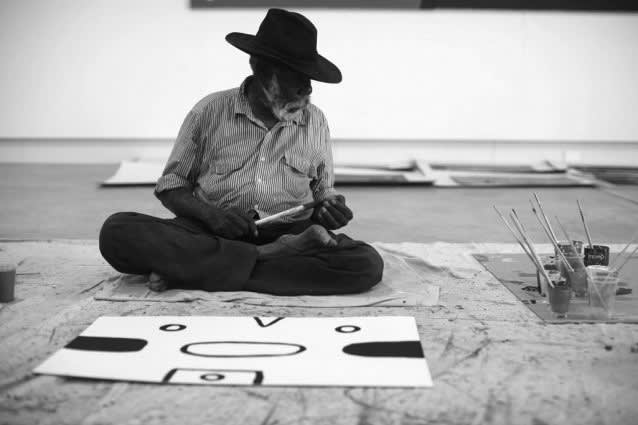Rammey Ramsey was a senior Gija man and was born on the Old Greenvale Station which is now part of the Bow River Station. His “country” and that of his parents is a part of Gija “country” in an area to the west of Bedford Downs near Elgee Cliffs. His Gija name, Warlawoon, is the general name for the whole of that area of country.
Ramsey was a key gure in the production of the Bedford Downs Massacre Joonba (a coroborree) that was staged at the 2000 Telstra Art Award. He is an inspired dancer who helped train the young boys in dancing. He and Rusty Peters made the dance poles used in the original Joonba.
Ramsey was true to his law, painting only country that he had rights to through birth and family. Most of his paintings are of the stunning gorge country north west of Halls Creek in an area surrounding Elgee Cliffs. He painted the places where the Rock Wallaby live and camping areas near waterholes. He applied paint with love and vigour, and his dots are like pearls stitched on a bed of pink and black raw silk. Images of cliffs, hills, rock wallaby holes, camping places, rivers, rocks in the river bed, waterholes, roads, stockyards and meeting places appear as distallations of important features of the landscape. A line might be a road or a river, a circle a waterhole, a place or a cave, a rectangle stock yards or hills.
In his late red paintings, Ramsey further developed the dynamics of his artistic language. Red paint that once surrounded the black representational forms of hills, rivers and stockyards are, in this late work, atmospheric elds that move in degrees from white, pink and red. e artist, observing his great friend Paddy Bedford painting, commented one morning that he wished to paint the Ngarranggarni way - the mixing of wet in wet of two colours on the surface of the canvas to create the gestural strokes and rhythm of the brush - spiritually a way to represent the four elements of life, earth, wind, re and water. ese late paintings are not the usual representations of country but are an important development in Gija art because they also convey the language of natural elements, so crucial in Aboriginal communication and foreseeing of events.
